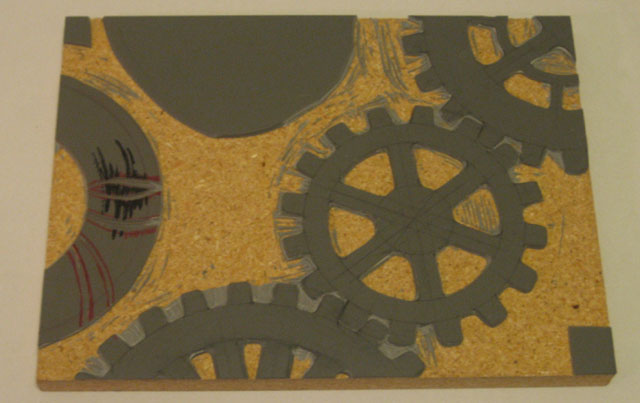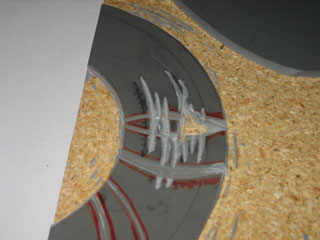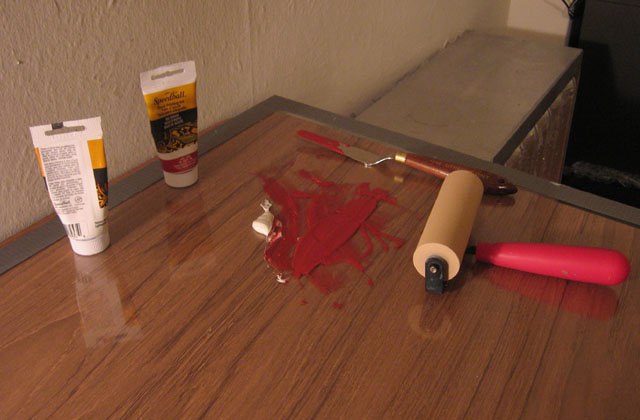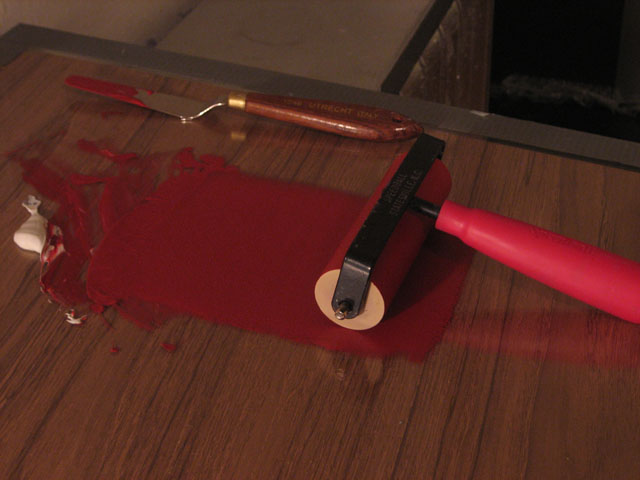This is the second article about how a woodblock print is made. In the last post, I talked about the materials and tools I use to make prints. In this post I show you how I carve the block and prepare the ink.
Carving the block
I’ve lead you on a bit. I really have.
I’m sorry.
Now I have to confess something. It’s a little embarrassing, but I hope you will understand a little.
I actually… don’t use blocks of wood for all my woodblock prints. A lot of the time I actually use linoleum. The linoleum is mounted on a woodblock to keep it rigid, if that counts.
Linoleum is similar to wood, and it is a little easier to carve, because it doesn’t have the grain that wood does. The printing surface is different, so the ink has a different texture when it is printed on the paper.
Here’s the block I am going to show you today to demonstrate how the ink is printed:

A carved linoleum block
This block is mostly carved already. There is one little bit of carving left to do. The arc on the left is designed to be reminiscent of a vase for flowers, so I will just call that the “vase”. I used a block marker to draw the area that I want to carve away.
I’d like a highlight on the curved surface, so I need to carve away this area so that ink will not print there.

Close up on the newly carved portion
I usually draw this outline in pencil, and I do not color it in like shown above. I used the black pen to make it easier for you to see in the photograph.
I use my X-Acto knife and gouges, and carve away the area I drew in black. I am very careful when I carve delicate areas like this, to make sure that I get the detail that I want, and that I don’t slip and make mistakes. A small area like this takes me about 15 minutes to carve.
The finished block is shown at the left. I am only going to print this vase in this run, the rest of the linoleum will be printed with other colors. I left the big blob of linoleum along the top edge uncarved, because I may eventually use that part of the block to carve another pattern into. I think another gear may look nice there.
The Ink Job
Now I get started with the ink.

The ink is mixed and ready to roll
I’ve mixed up some red ink with a touch of white. The ink that I am using is basic woodblock printing ink that I got from the art store. I use oil-based ink, because I think it lasts longer and looks better. Oil-based ink takes longer to clean up, and requires nastier chemicals like paint thinner.
I use a palette knife to mix the ink together, and when it is all mixed, smear it in a line about the width of my roller. The roller itself is a soft rubber roller. In general, rollers come with either soft rubber or hard rubber surfaces. I prefer the soft, because it covers the block with ink better.
Just like it is easier to spread soft butter across a piece of toast, it is easier to get the ink spread onto the block with a soft roller. The roller conforms to the surface of the block, and accounts for the uneven surface of the block.

I roll out an even layer onto the glass from the fount
One thing you will notice in the photo above is that the roller is rested on its back. If the roller is left resting on the roller portion, a flat dent can form in the rubber itself. This isn’t such a big deal with these cheap rollers from the art store, but once I get the roller I want, it will matter quite a bit. Good rollers are made of high quality rubber, and cost well over a hundred bucks.
A quick aside – I roll out the ink on a big sheet of glass. Glass is a perfect surface to roll ink on because it is very smooth, and it is not porous, so the ink does not soak in to the surface at all. This makes it easy to scrape the ink away, and to clean it up when I am done.
Next I roll out the ink as shown above. I don’t roll out all of the ink, but just the right amount. Learning what the right amount is takes a little experience. I can’t quite explain it, because I know the right amount because of how the roller feels rolling the ink, and how it sounds.
If the ink is too thick, the print will get smooshed, and the detail will be lost. If the ink is too thin, then it won’t print dark enough, and will look thin. To continue the toast analogy, when the ink is too thin, it is like trying to cover your toast with not enough butter.
The ink across the top is called the fount. When the ink gets too thin, I dip the roller into the fount and roll it out.
Coming Attractions
Ok, I am WAY over my morning writing power hour now, and I have to go get ready for work. Next up, printing the block, lining up different colors, and a progress report.
Tags: 101, Woodblock Print
“Morning Power Hour.” I like it. Can I get a few for myself? I’ll take a half dozen please.
Good to see this project is rolling right along!
.-= Dave Doolin´s last blog post ..WordPress Gotcha! Find Out If Your RSS Feed is Helping or Hurting =-.
You can have a couple power hours. Go right ahead!
eventhough I squander most of my working day on the net trying to play video games like zynga poker or farmville, I always like to utilize some spare time to look at a small amount of blogs now and then and I am grateful to report this latest blog post is genuinely somewhat good quality and quite superior than 50 % the various other poor quality stuff I read today , anyways i’m going to take up a few hands of facebook poker
Hey, ich bin genau deiner Meinung. Werde mich mal für Updates anmelden. Bin schon gespannt mehr zu lesen.